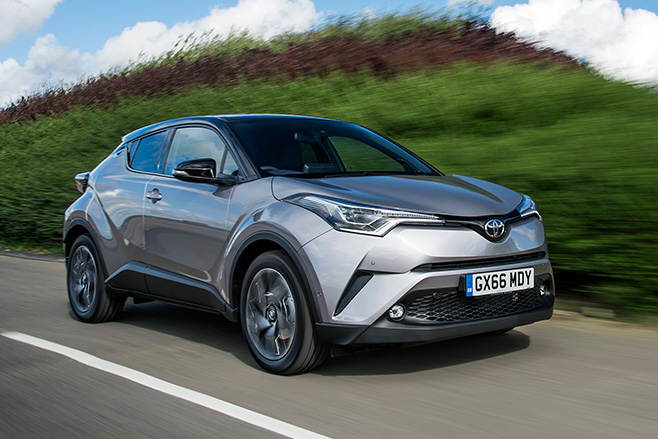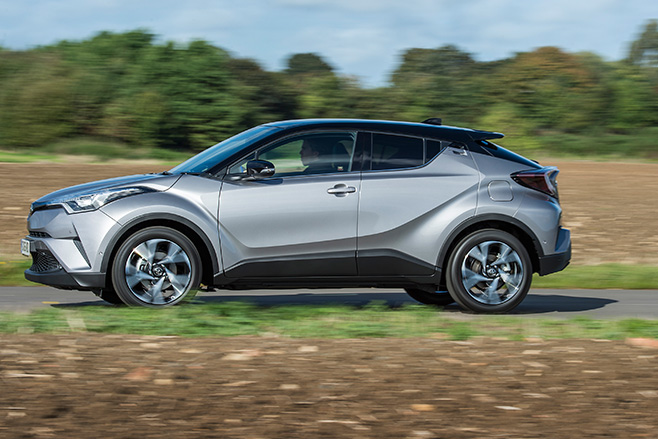
You don’t expect radical from Toyota any more than you expect diesel from Ferrari, but the Toyota C-HR is a dramatic departure for the normally conservative brand. It’s an aggressively styled crossover that will come with a new 1.2 litre turbo engine and the option of front- or all-wheel drive.
TELL ME ABOUT THIS CAR
Let’s start with the name, which Toyota tells us is meant to decrypt as ‘Coupe – High Riding.’ While the reality is that the C-HR is a crossover that’s been designed to offer buyers a more interesting alternative to a conventional five-door hatch, the company still deserves full marks for trying – and succeeding in delivering something so completely different. We’ll only get one powerplant, a new 85kW 1.2-liter petrol motor that will be offered in front-drive form with either a six-speed manual gearbox or a CVT automatic gearbox, and in all-wheel drive with the autobox.

STRENGTHS
- Looks – it’s like all of the frustrated ambitions of Toyota’s design team have found expression in one car. We genuinely can’t remember the last time the company made a production car that looked this radical. Although styled to resemble a ramped coupe the C-HR actually manages to deliver an impressive amount of the practicality that crossover buyers are looking for, with disguised rear doors.
- Space: The C-HR is fractionally shorter than a RAV 4 and pretty much the same size as its most obvious rival, the Nissan Qashqai. Beneath the swoopy exterior design there’s an impressive amount of room for both occupants and stuff. The rear is accessed by doors which use hidden handles in the rear pillars, and although the door aperture is tight there’s plenty of room in the back, even for adults and a respectable 377 litres of storage space as well.
- Equipment: Two trim grades will be offered in Australia, with adaptive cruise control, a reversing camera, automatic high-beam headlights, lane departure warning and autonomous emergency braking (which can stop the car before a low-speed collision occurs) coming as standard. The higher-spec Koba will get bigger 18-inch alloys, part-leather trim and keyless entry.
- Ride: The C-HR sits on Toyota’s new (and expensively developed) GA-C platform, which also underpins the new Prius. This is very stiff and has allowed the engineering team to create a chassis that delivers impressively pliant ride, even when asked to cover rougher roads at speed.
- Engine: The 1.2-litre turbocharged engine doesn’t have a huge amount of power, but it’s keen and willing with a responsive mid-range that makes it easy to drive quickly and effortlessly. It doesn’t want to rev that hard, but it’s got a nice rorty exhaust note when sampled with the manual gearbox (the CVT makes it drone.)
- Manual box: Although the manual gearbox will be a minority choice in Australia, it’s a good one – slick and accurate and even having a ‘rev matching’ function to help smooth out downchanges.

WEAKNESSES
- Handling: The sporty looks aren’t matched by an equally dynamic driving experience. The C-HR handles tidily and accurately, but without any real flair or enthusiasm when pushed hard. It’s a sports-free sportscar.
- Tyre noise: Although the C-HR’s cabin is impressively quiet on smooth surfaces we noticed a surprising amount of tyre noise gets transmitted on rougher tarmac.
- Claustrophobic cabin: The tiny rear windows mean that although there’s plenty of space in the back anyone relegated back there is likely to feel claustrophobic. Only bigger kids will be tall enough to see out.
- CVT gearbox: Most of the time the CVT automatic gearbox does a decent job, but requests for hard acceleration leave the engine droning and the pretend ratios of its ‘Sport’ mode slur too much to be taken seriously.
- Smaller touchscreen: Other markets will get an 8-inch touchscreen display, but Australia will have to make do with a smaller six-inch unit.
- No hybrid: Toyota says it won’t be bringing the Hybrid engine model that will be offered in some other markets to Australia, which is a pity as it basically offers the Prius’s running gear with a far more visually interesting package.

ANY COMPETITORS I SHOULD CONSIDER?
There are already a fair few crossovers out there but the C-HR’s Toyota badge is likely to appeal strongly to those seeking reliability and a drama-free ownership experience. We’ll have to wait until closer to the February on-sale date for pricing, but we can safely predict that the C-HR will undercut the similar-deal Audi Q2 by a significant amount when it arrives later next year and might well be stylish enough to attract some buyers from the second-generation Mini Countryman.
Of the existing pack it’s got more visual flair than the Nissan Qashqai – which is at $28,490 with a CVT – and more practicality than the outré Nissan Juke, which is $24,490 in CVT form.
You’d have to say it looks good compared to the staid Mitsubishi ASX CVT ($26,990 in LS form) and even the sweet handling Peugeot 2008 1.6 Active ($25,490).



